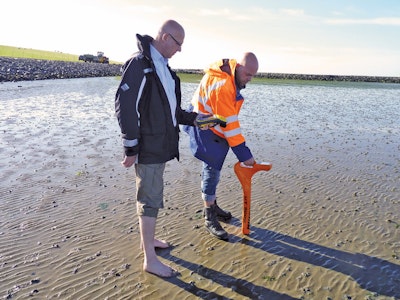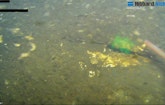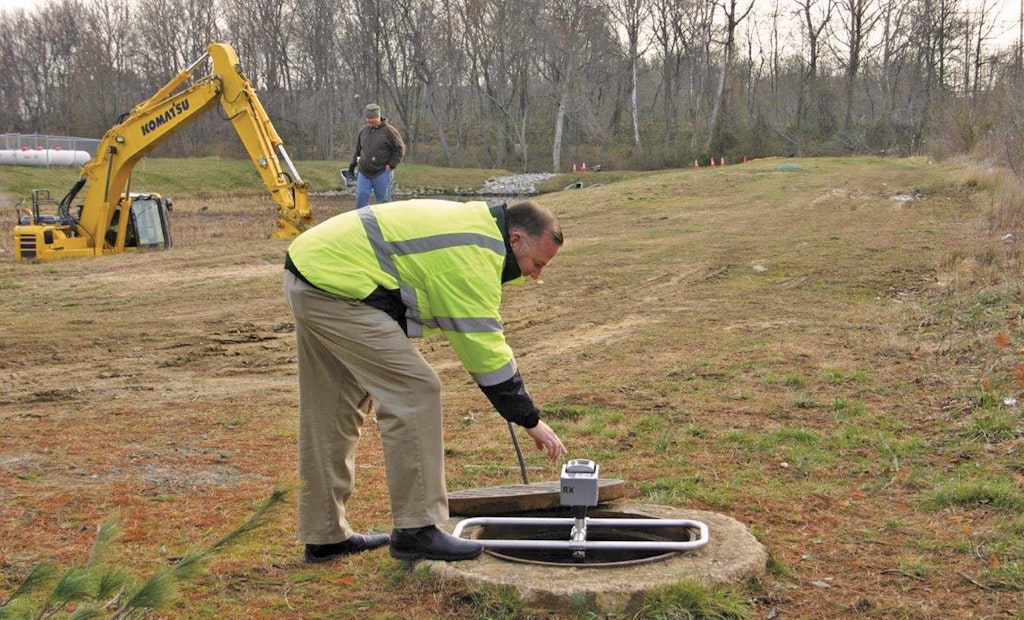Interested in Inspection?
Get Inspection articles, news and videos right in your inbox! Sign up now.
Inspection + Get AlertsSystem helps locate pipes under mudflats
Problem: The Wadden Sea in the North Sea with its coastal regions in Denmark, the Netherlands and Germany is the largest system of mudflats in the world. Local water utility Wasserverband Nord had to locate and document a freshwater pipe between the mainland and the island of Pellworm, but the tide comes in twice a day and the area is only safe to walk on for a maximum of six hours when the tide goes out.
Solution: Wasserverband Nord enlisted the help of Hermann Sewerin GmbH to accurately locate and document the pipe using a cable running parallel to the pipe. Sewerin provided the UT 9000, which is supported by an external GPS system, the Geo-Explorer by S+H Systemtechnik GmbH. The device’s self-explanatory menu navigation guides the technician to the position of the pipe one step at a time. Their lightweight and superior ergonomics make the devices easier to transport through the sticky mud. The high-contrast LCD monitor is clearly legible, even in extreme lighting conditions.
Result: The device helped locate the pipe in a short time, save the coordinates and accurately document the location. 888/592-9916; www.sewerin.com.
Leak detection sensor and swimming ROV used to find leak in Latin American conveyance tunnel
Problem: A Latin American client was worried a leak within a large water conveyance tunnel could undermine nearby structures. The client needed to better understand the location and severity of the leak creating the problem.
Solution: Hibbard Inshore was asked to locate the leak. Hibbard had recently tested a sensor that locates leaks and seepage by using electrical logging to measure amperage/voltage along with electromagnetic field readings from outside the pipe/tunnel. The measurement probe was carried into the flooded pipe with a swimming ROV. The electrical logging inside the tunnel required a circuit with an outside connection. Electrical current deviations were recorded and logged with payout to identify potential leak sites. The electric current follows the preferential groundwater flow path, or the path of least resistance, to complete the circuit, therefore allowing Hibbard Inshore to identify magnetic field intensity to determine conductivity zones or transport porosity.
Result: Reviewing the visual information along with the electric logging, technicians were able to narrow down the possible location of the leak, which was observed with CCTV while they remotely released dye to visually and physically verify the leak’s location and cause. Technicians also provided a 3-D, georeferenced surrounding area map of the observed conductivity patterns. 248/745-8456; www.hibbardinshore.com.
Acoustic inspection approved as part of cleaning mandate
Problem: New Castle County, Delaware, serves a population of over 550,000 that generates 50 mgd of wastewater, which is conveyed using 1,700 miles of underground sanitary sewer pipes. As part of a mandate from the Delaware Department of Natural Resources and Environmental Control, they are required to clean 500 miles per year, which roughly equates to a three-year cleaning frequency for the entire system.
Solution: InfoSense’s Sewer Line Rapid Assessment Tool, or SL-RAT technology was developed for rapidly identifying sewer line blockage conditions. It is based on measuring an acoustic signal transmitted between manholes in an active sewer line segment. As part of the initial pilot study, 56,000 linear feet were evaluated in mid-2014. An average of seven line segments (1,450 linear feet) per hour was achieved.
Result: Results showed that less than 10 percent of the inspected pipes needed immediate cleaning, which created an opportunity to better allocate resources to pipes that actually needed attention. Pilot studies have continued, and to date over 1,450 inspections have been performed (320,000 linear feet). On average, over 55 percent of the pipes received a “Good” score (7–10) and only 11.4 percent needed immediate cleaning (acoustic score of 0–3). Use of the SL-RAT has been approved by DNREC and the EPA to count toward the annual 500-mile cleaning requirement. There are no immediate plans to reduce cleaning. Instead they’ll use the preliminary acoustic inspection data to focus cleaning efforts on the pipes that actually need it. 877/747-3245; www.infosense.com.
Camera system used to inspect backyard catch basins
Problem: New stormwater requirements in Ontario, Canada, required adding catch basins to residential storm drains. All residential developments needed to add backyard 2- by 2-foot concrete basins for the collection of stormwater runoff. Inspection of these basins is standard maintenance, to be done on a regular basis by an inspection contractor. Kls Inspection Services needed a camera to do the job.
Solution: Basins are located in backyards on the opposite side of the building lot driveway. The contractor must park on the street at the driveway to complete the inspections. Using his Pearpoint P350 system from his mainline camera truck, owner Kurt Streick pulls his cable all the way around the house. Using yard rollers to protect his cable, he lowers his 354 P&T camera into the basin and drives around the 45-degree bends and the 100-plus feet of remaining pipe to show the connection to the main.
Result: “My push cameras were too small for 10-inch pipe,” Streick says. “I decided to try my small CCTV crawler and it worked perfectly.” The compact size of the P350 allows it to drive around the 45-degree fittings and then power down the 10-inch main pipe. 800/688-8094; www.pearpoint.com.








